If there seems to be one constant with we humans, it is that we spend much time tearing down vestiges of our past to make room for the supposed future. We build bigger, taller, and seek the more modern, or the more profitable. Many venerable buildings have met the wrecking ball, and although some are well remembered, such as New York’s Pennsylvania Station, others are largely forgotten. One such forgotten New York City gem is the New York Central’s 138th Street station. Upon construction it was considered one of New York City’s most notable examples of Richardsonian Romanesque architecture. Featuring a beautiful clock tower, and ornate terra cotta detailing, this is one place that is definitely worth remembering.
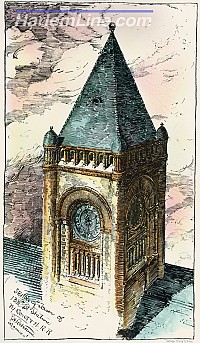 In the northeast, Romanesque style train stations were mostly associated with the Boston and Albany Railroad, which designed most of their main line stations in the style (for example, Chatham, which was a joint Harlem Division station), and many by pioneer architect Henry Hobson Richardson. However, the New York Central did have a few – Richardson proteges Shepley, Rutan, and Coolidge designed the Dobbs Ferry, Irvington, and Tarrytown stations located on the Hudson Line. The railroad also hired Robert Henderson Robertson to design stations at Canandaigua (extant, but heavily modified), Schenectady (demolished), and most notably, 138th Street.
In the northeast, Romanesque style train stations were mostly associated with the Boston and Albany Railroad, which designed most of their main line stations in the style (for example, Chatham, which was a joint Harlem Division station), and many by pioneer architect Henry Hobson Richardson. However, the New York Central did have a few – Richardson proteges Shepley, Rutan, and Coolidge designed the Dobbs Ferry, Irvington, and Tarrytown stations located on the Hudson Line. The railroad also hired Robert Henderson Robertson to design stations at Canandaigua (extant, but heavily modified), Schenectady (demolished), and most notably, 138th Street.
R.H. Robertson was born in Philadelphia in 1849, and graduated Rutgers College in 1869. He started his architecture career working in the office of Henry Sims in Philadelphia, later moving to New York and working in the office of George B. Post. By 1871 he established his own architecture firm in New York City, designing a wide array of buildings from libraries to churches, as well as banks, train stations and private homes. Over the years he worked in various styles, including Queen Anne and Victorian Gothic, but by 1880 became heavily influenced by Richardson’s Romanesque revival style. Robertson was, however, described as “[taking] up the style in his own way.” His prolific New York City career led him to design various buildings that are today designated landmarks, including the Lincoln Building at Union Square, and Fire Engine Company 55‘s firehouse in Little Italy.
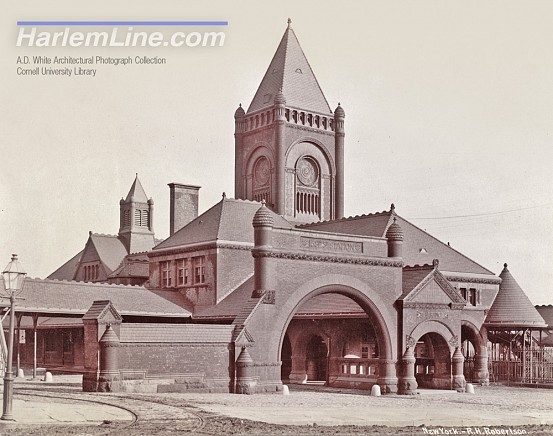 Â
 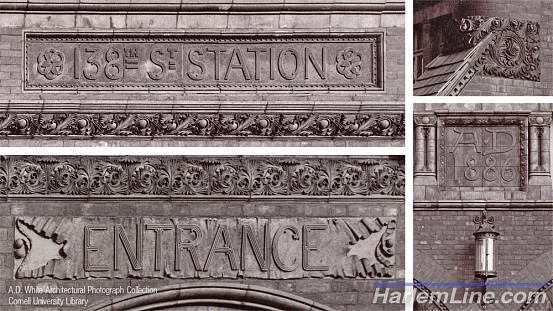
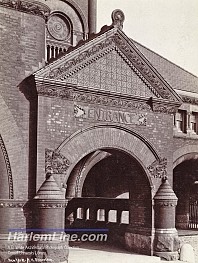 Â
 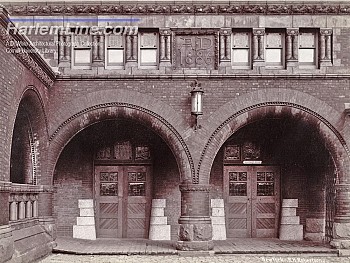 Â
 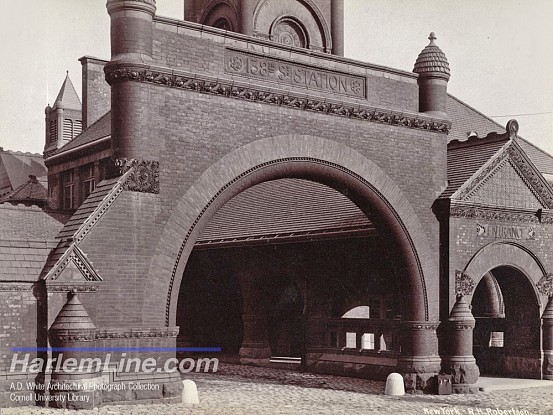
138th Street Station shortly after construction. Original photos from the Andrew Dickson White Architectural Photograph Collection, Cornell University Library. Photo restoration work by HarlemLine.com
Constructed in 1886, Robertson’s design for 138th Street was a 2 story brick building with peak tile roof, at a cost of $65,000 (about $1.6 million today). Typical of the Richardsonian Romanesque revival style, the building featured various arches, squat columns, cylindrical towers, and rusticated stone. Adding to the character of the building was a large clock tower, 80 feet high, and catching the eyes of all who passed by. Originally the station was at grade level, with two tracks crossing 138th Street, however upgrades were soon needed.
With the railroad’s steadily-growing service, and new requirements set forth by the US Army in regards to clearance for ships around New York City, significant upgrades were made to the right of way in the south Bronx and northern Manhattan in the 1890s. Primary among the changes was a viaduct raising the tracks above 106th Street to 149th Street, a new bridge crossing the Harlem River, expanding the tracks from two to four across the river and allowing better clearance for ships passing below, and adjusting the track curvature in the Bronx. The 138th Street Station was unfortunately in the way of these plans, and dealing with the station became an additional part of the project. Then was, of course, a rosy time, with railroads at their height and what appeared to be a never ending stream of profits. New York Central brass gave the go-ahead to draw up plans for the nearly insurmountable task of moving the large station without harming its delicate brickwork and intricate terra-cotta designs.
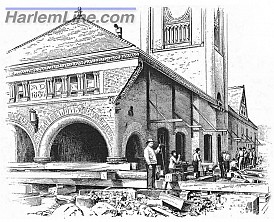 Â
 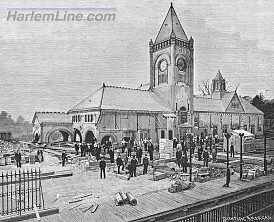
The moving of the great station, images published by the Scientific American in 1894.

Diagram of the station after moving, with new platforms.
The railroad hired B. C. Miller, who was no stranger to moving the near impossible – having relocated the 5000 ton Brighton Beach Hotel a few years previously. Despite being lighter than the hotel, the station posed more difficulty as its weight was very unevenly distributed. The tower alone – 19 feet square and 80 feet high – was estimated at 500 tons, and the entire station about 1200 tons. Using a series of fourteen jack screws, nineteen men gradually turned them in unison, timed by the sound of a bell. With each turn the station very gradually moved, taking an entire week to be situated in its new location. Not everyone was impressed with the move, however. In an article discussing the work of Robertson, the author described the changes as “[having] been carried out with a quite ruthless disregard of or insensibility to the merits of the work, and have destroyed or mutilated the dependencies that were integral parts of the composition.” Likely the author refers to the new porches and walkways erected around the building, allowing passengers to access the newly elevated track platforms from the second story of the structure.
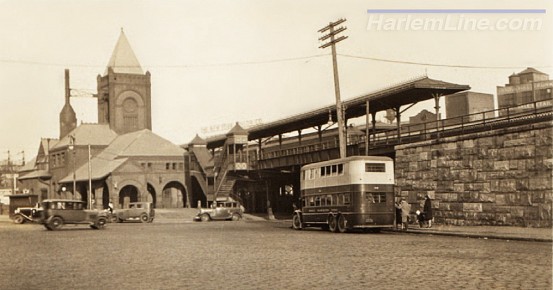 Â
 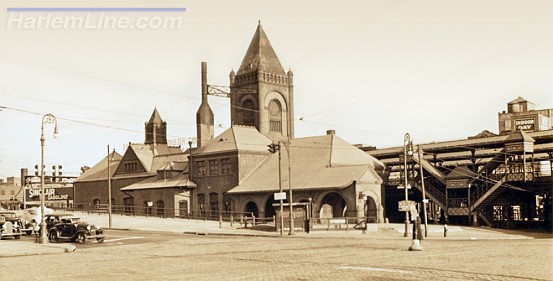 Â
 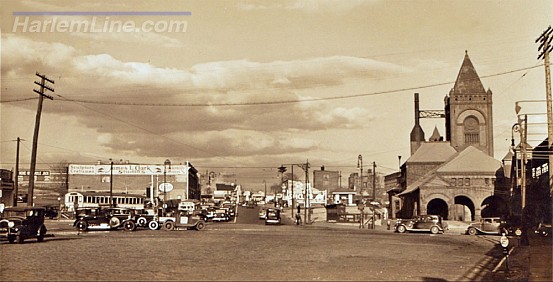
New York City’s staff photographer Percy Sperr captured these images of the station, circa 1935. From the collection of the New York Public Library.
By the late 1950s, the cash-strapped New York Central looked to sell many of its passenger stations, and 138th Street station was one of several on the Harlem Line to be put up for sale (most prominently, Mount Vernon was sold in 1959). By 1964 a buyer – Golden Eagle Inc – had materialized. A real estate development company run by John A. Dilliard, Golden Eagle found value in the 56,517 square feet of land attached to the sale, but not the station itself. (Dilliard attempted to buy land on both sides of 138th Street near the station, which later led to legal battles with the bankrupt Penn Central and the City of New York) New York Central’s employee magazine Headlight paints a rosy picture of the sale of the “historic landmark” in its June 1964 edition, calling the depot “the finest and most complete way station in the country” upon construction. The more realistic depiction, however, made the front page of the New York Times on Sunday, April 26, 1964: “Picturesque Depot to Be Razed in Bronx.” For reportedly $170,000 (approximately $1.3 million in today’s dollars) the New York Central parted with the old station, and it was torn down shortly thereafter.
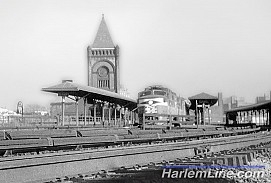 Â
 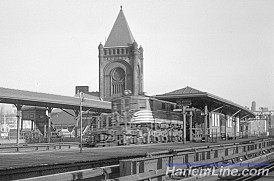
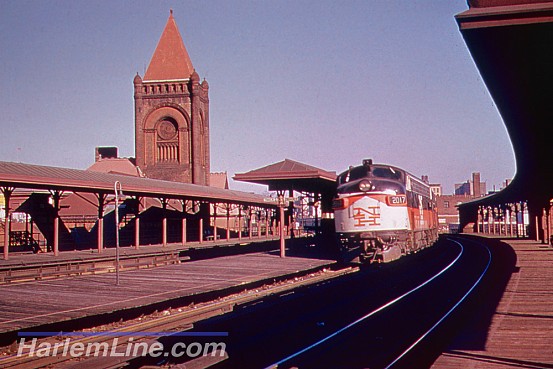
Trains at 138th Street in 1958.
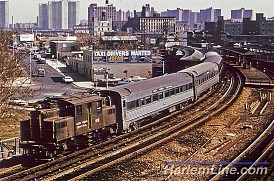 Â
 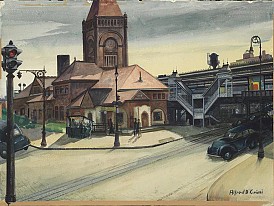
138th Street in photo and in paint – Alfred D Crimi painted this rendition of the station circa 1950.
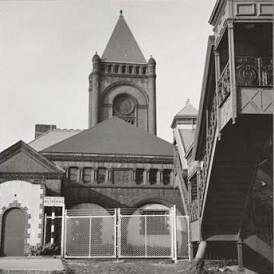 Â
 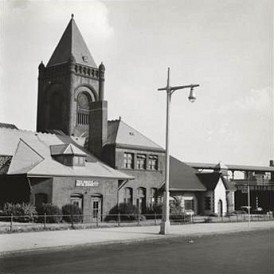
Alfred C Loonam photographs of 138th Street, circa 1955. Photos from the Museum of the City of New York.
Whether anyone mourned the loss of this great station is unknown. Its destruction came right on the heels of the loss of the great Pennsylvania Station, though it was a year shy of the establishment of the New York City Landmarks Preservation Commission. Though there is no doubt that had the Commission existed they would have bestowed this noteworthy station with a Landmark title, it is uncertain if anyone would have truly fought the railroad if it pressed for sale and demolition, as many did for Grand Central. Even with the loss of its grand depot, 138th Street remained a stop on the line, with a small replacement station constructed by the Central. Eventually all stations were to receive high-level platforms to accommodate the line’s new “Metropolitan” MU cars, and the station’s curvature and tight space deemed it not worthy of such an upgrade. The November 28, 1972 timetable is the last to list the 138th Street, and shortly after even the small replacement station was demolished. With a subsequent track realignment, little trace of a station ever being here remains. It seems that although 138th Street could survive one major landscape change, it couldn’t survive a second.
Other than among the biggest rail buffs, 138th Street station has been largely forgotten, with information about it hard to come by. Several name changes over the years no doubt adds to the confusion and enigma surrounding this place. Although the architect always knew it at 138th Street (it was this name that was designed in terra cotta on the station’s front), many (including the railroad) referred to the station in the 1800s and early 1900s by the surrounding neighborhood’s name, Mott Haven. The IRT established a subway station across the street which also went by the name Mott Haven, but a local businessman petitioned the subway in 1921 to change the station name due to confusion between it and the next stop of Mott Avenue (today’s 149th – Grand Concourse station). Following suit, the name Mott Haven fell out of favor for even the New York Central’s station, but the railroad was also known to simply call it The Bronx. After spending long hours searching all three names of this station (including examining rolls of microfilm for property records at the Bronx Business Center) and slowly gathering an array of tidbits, I was able to weave what seems to be the most complete history to date of this lost station. Although the station itself might be gone, there is still a story to be told – one of 138th Street’s current state and future.
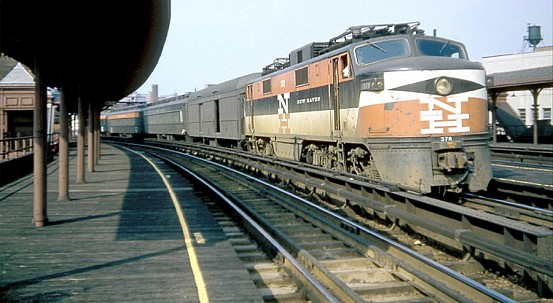
In Bill Volkmer’s widely-forwarded slideshows of NH locomotives, you’ll find this shot at 138th Street
Over its 184-year history, the New York and Harlem Railroad has certainly seen stations come and go. Much of the railroad’s abandoned former right of way in Columbia County, for example, has reverted back to wilderness. However, it is hard to imagine any part of New York City proper reverting back to the wilds. In some ways, though, 138th Street did return to that state. After the great depot was knocked down in 1964, nothing else was ever constructed on the land south of 138th Street. Once the station itself was finally eliminated in 1973, and the underpass covered up, the slices of land next to the tracks on both sides of 138th sat dormant. Abandoned, to become slowly reclaimed by nature (and at some point reclaimed in property ownership by the City of New York). Around 2008, however, various individuals and groups including For A Better Bronx and More Gardens! noticed the land on the south side and worked to create a community garden there. By the winter of 2009, La Finca del Sur was founded on the site of the former station platform and exit, and the garbage and high weeds were gradually removed from the lot. In their stead came planting beds and trees. Largely led by Latina and Black women, the farm has plots open for members to grow their own plants, and occasionally holds farmers markets and events for the community. Members have the ability to further their knowledge through practical applications in the garden, as well as taking classes at the NY Botanical Garden in subjects such as soil testing, composting, and pruning.
You’ll find a wide and varied amount of things growing in La Finca: sunflowers for phytoremediation, plums, apples, pears, peaches, grapes, marigolds for attracting insects, roses, strawberries, onions, mint, garlic, cilantro, lavender, basil, tomatoes, potatoes, peppers, and more. Metro-North trains rumble by every few minutes, and the ground underfoot vibrates with the passage of a subway train below. Among the planting beds are various grates that lead directly down to the subway tracks, and the occasional message from the platform’s PA speakers can be just barely heard. The grates serve as an emergency egress from the subway, but are old and rusted, and now surrounded by protective orange fencing erected by the MTA.
While the loss of such a monument as 138th Street is quite heartbreaking, from the ashes has slowly risen this farm – something that the people of the South Bronx can be proud of. Many of the people I met at La Finca were unaware of the grand station that once stood there, but perhaps now that the history of this place is known, the legacy of 138th Street will live on.
Special thanks to Marilyn Ibach from the Prints and Photographs Division at the Library of Congress and Nancy Ortiz-Surun, Gloria Weiss, and Wilfred Gonzalez at La Finca del Sur for their contributions to this post and my research.
La Finca del Sur is always looking for donations and volunteers – if you can spare a hand, drop them a line at infosbufc@gmail.com.


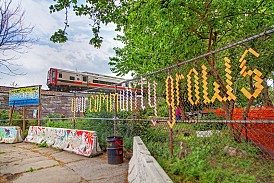
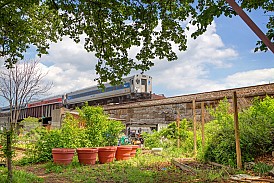
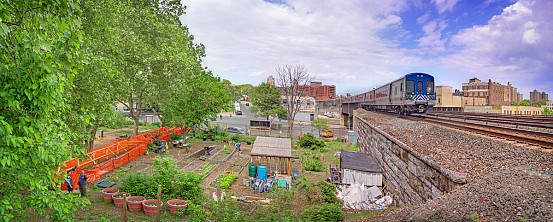
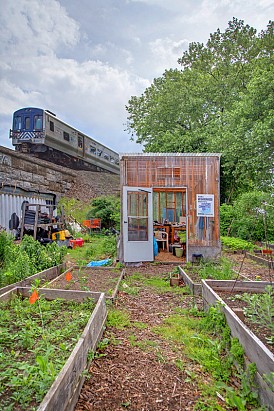
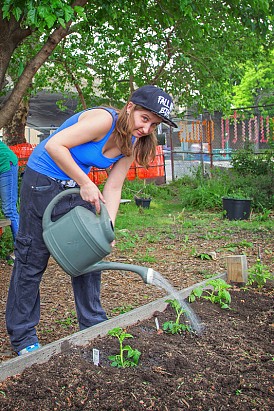
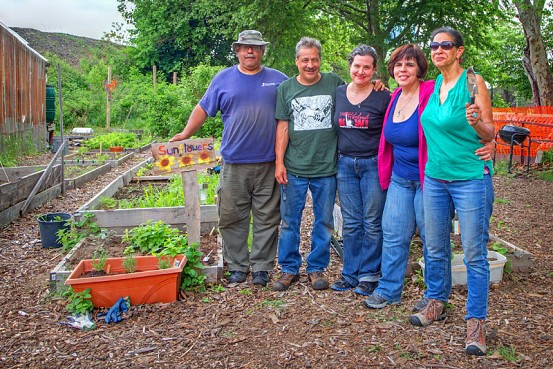



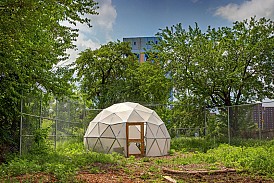
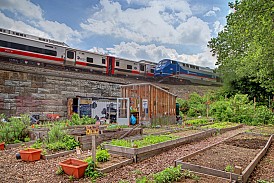
“R.H. Robertson was born in Philadelphia in 1849, and graduated from Rutgers College in 1849.” I didn’t think that was possible.
Bwahahaha, he was especially talented! Thanks for catching that, I fixed the typo. Graduation year is 1869 :)
A fascinating story, well-told (as usual). And great pictures too. Thanks. As a kid growing up in the Bronx, it’s theoretically possible that I could have seen that station (though it’s unlikely and, alas, I have no memory of it). But we do have a fine example of the Richardsonian Romanesque style right here in beautiful Ulster County. It’s Mohonk’s 1907 Testimonial Gateway, designed by James E. Ware & Sons, New York.
1972 high level platform construction. I remember that — I lived in White Plains at the time. When I saw the mention of 138th Street station, my immediate thought was “isn’t that the station that disappeared?” Mott Haven was how some of my railfan friends always called it.
I love this blog. Haven’t been back in the area since the mid-70s and you do a lovely job of reminding me of my teenage years, as well as updating me.
Thanks.
Dr. Phil
I remember seeing the platforms at 138th St as a little kid riding through on the train, but this being the early 1970s, had no idea such a building had ever stood next to the tracks there. Slides I shot of eastbound trains coming off the Harlem River lift bridge in 1990 show no evidence of even the platforms by that time.
Having commuted from Crestwood in the late sixties and early seventies, I remember the platforms and the local stopping there. I don’t remember the building. Amazing research job!
Very interesting read! I always knew of the station, but wasn’t aware of the grand station house that was there. From the photos it reminds of a cross between NJT’s Newark-Broad and Amtrak’s Hartford Station. Thanks for posting!
Excellent post! Great photos and superb research. Have always wanted to learn more about this station. You knocked this one out of the park. Maybe you could add a graphic of an aerial or map view from Google Maps with an outline of the plot of land where the station was? Might make things more clear. Anyhow, great job. Also, have you visited the Andrew Dickson White Library? (https://olinuris.library.cornell.edu/history/uris/adwhite) It’s amazing. I spent four years up there and sadly didn’t visit that place often enough.
Thanks! You’re right, an aerial might help… the nice old station was located on the north side of 138th (I think there is some addiction clinic or something like that there now, the city owns the property now as the owner never paid their taxes), and the platform extended over the street with an exit and underpass on the south side (where the garden is now). I’m not 100% sure where the temporary station (1964-1973) was located, I thought it was on the south side where the garden is, but I talked to some folks with the parks department and they’re not quite sure.
As for the library, I’ve only seen their collections online. Looks like a really awesome place, though!
Emily , ANOTHER splendid addition to your extensive list of impressive accomplishments in the realm of historical information pertaining to subjects /objects that most people did not know ever existed; Thanks!!!
Hi Emily – I’ve been following your blog for several years, and I’ve been impressed from the beginning, but your work on the story of this station is fantastic. I’ve been trying to research it for years myself to no avail. Thank you for doing this. I now can do a painting of it, and possibly a model. – Peter
Incredible read! The Bronx has such a fascinating history, and it’s a shame that more of it isn’t documented. It’s a sham that such a delicious piece of architecture was razed. Hopefully, you’ll report on other lost stations in the future. Great article!
I believe there is so much potential in areas such as Mott Haven and many others around the 5 Boros that could use refreshing and cleaning up and revitalizing. MOTT HAVEN for expample especially the area around LINCOLN HOSPITAL to 149th Street and Grand Concourse, FIRST there is the Teaching Hospital – Lincoln. the Bronx General Post OFfice, Hostos College, the resurgence of the South Bronx residential neighborhoods, other industrial businesses especially between 138th street and Lincoln over to the river, Yankee Stadium not far away and the Bronx Terminal Market BJs, etc to the west, and a host of other reasons — METRO NORTH should consider rebuilding MOTT HAVEN STATION @ 149th Street between the hospital and HOSOTS complexes wideining the bridge and repositioning the tracks so that there would be more usage on the Harlem line from there to Mount Vernon West and the HUSON LINE from MH to Spuyten Duyvil on the HUDSON and include a new MOTT HAVEN stop for New Haven Line along with Fordham to take passengers to eastern Westchester and Connecticut. It could act as a junction to Yankee stadium for shuttle also.
It could also have connection to the 149th Street subway of the 2 and 5 for passengers needing to get to other areas RATHER THAN having to go to HARLEM – 125th St. It would certainly bring in ore business as well as help aleviate corwding at 125th on both the MNR and the 4/5/6 subway lines.
Then there are buses along 149th street to Third Avenue eastbound and all the way to Riverside Drive in Manhattan westbound helping to feed commuters to upper manhattan as well as other areas.
Since there is residential building in the South Bronx/Mott Haven area specifically and over the next few years you will have a slew of new middle income residents and lower income residents who may begin to increase their earnings by being able to get to jobs if they can take the train from a MOTT HAVEN, 149th St. Station.
A 149th Street-Mott Haven station may even rival Fordham Road becase all THREE MNR lines would use it as both a beginning and ending point and if the railroad ever decided a transfer point.
JUST A THOUGHT.
I remember 138th St as a kid with my nose pressed up against the front window of the old NHRR commuter trains. I always wondered about the station, but as an NYC station, we never stopped there. I wondered why it had been taken down, but I don’t remember the sharper curve that was obviously the problem.
Great article – thank you!
Excellent post – great job.
where in the Bronx??
My father took me there just before the building was demolished. He remembered when the 369th Harlem Hell Fighters marched across the Madison ave bridge to head to the second world war from the old station.
As a kids, we would sit on the benches during the rush hour and watch the trains come through the station. Specifically the P motors of the New York Central on the Hudson line as they headed up state and the New Haven washboards and older MUs as they were head up to New Haven and beyond. I remember how the station platform would vibrate as the trains came through. I remember the NYC Transit strike when I got to ride one of the New York Central Prewar MUs from that 138th street station to Grand Central Station in order to go to work. When I lived in Albany, NY, I would take the train to the city before they switched to Penn Station, to Grand Central Station. As the train would pass through the 138th St station, I would remember sitting on the bench watching the trains. The station is gone now but the memories are still there.
I was watching “The Seven-Ups” with Roy Schneider. A scene, really scenes, at the Lucia funeral home (569 184th street, bronx ny) prompted me to look at maps, so I did. It is still there in the exact same location almost 50 years later. However, in one of the scenes, when the procession is leaving, in the background you can see the elevated train. But it isn’t there anymore. Totally gone. Tried to find out when, but couldn’t. Do you know when they took down the train in that area???
Thanks
James